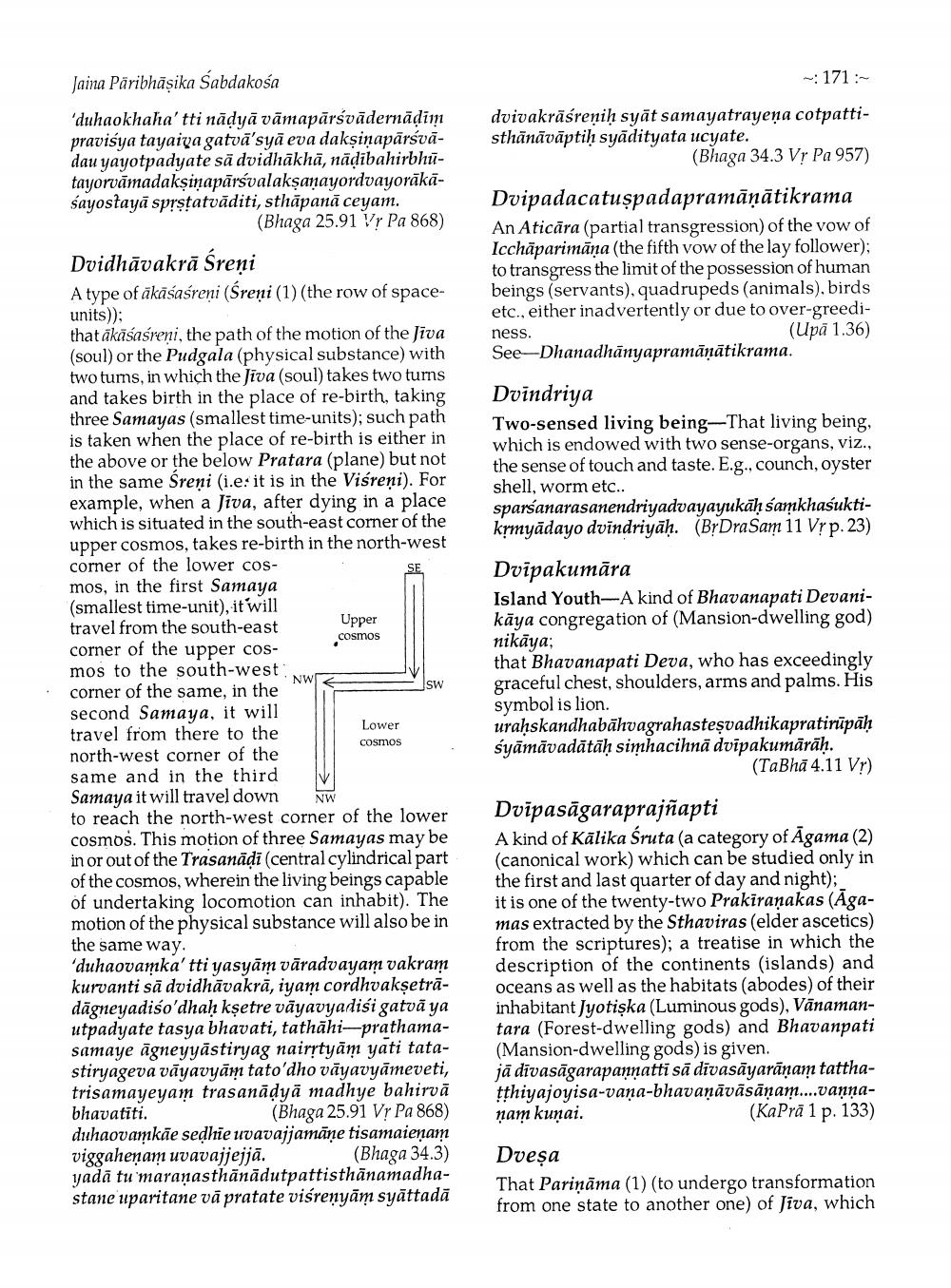________________
171 :
dvivakrāśreņiḥ syāt samayatrayeņa cotpattisthānāvāptih syādityata ucyate.
(Bhaga 34.3 Vy Pa 957)
Dvipadacatuşpadapramāṇātikrama An Aticāra (partial transgression) of the vow of Icchāparimāņa (the fifth vow of the lay follower); to transgress the limit of the possession of human beings (servants), quadrupeds (animals), birds etc., either inadvertently or due to over-greediness.
(Upā 1.36) See-Dhanadhānyapramāṇātikrama.
Dvindriya Two-sensed living being-That living being, which is endowed with two sense-organs, viz., the sense of touch and taste. E.g., counch, oyster shell, worm etc.. sparsanarasanendriyadvayayukāḥsamkhaśuktikợngādago doindrigãy. (BrDraSam 11Vrp. 23)
Jaina Päribhāșika Sabdakosa 'duhaokhaha' tti nādyā vāmаpārsvädernādim pravisya tayaiya gatvā'syā eva dakșinapārsvādau yayotpadyate să dvidhākhä, nädibahirbhütayorvāmadaksinapārsvalakşanayordvayorākāsayostayā sprstatvāditi, sthāpanā ceyam.
(Bhaga 25.91 Vs Pa 868) Dvidhāvakrā Śreņi A type of ākāšaśreni (Śreni (1) (the row of spaceunits)); that äkäsasreni, the path of the motion of the Jiva (soul) or the Pudgala (physical substance) with two tums, in which the Jiva (soul) takes two turns and takes birth in the place of re-birth, taking three Samayas (smallest time-units); such path is taken when the place of re-birth is either in the above or the below Pratara (plane) but not in the same Sreņi (i.e: it is in the Viśreni). For example, when a Jiva, after dying in a place which is situated in the south-east corner of the upper cosmos, takes re-birth in the north-west corner of the lower cosmos, in the first Samaya (smallest time-unit), it will travel from the south-east
Upper
cosmos corner of the upper cosmos to the south-west corner of the same, in the second Samaya, it will
Lower travel from there to the north-west corner of the same and in the third IV Samaya it will travel down NW to reach the north-west corner of the lower cosmos. This motion of three Samayas may be in or out of the Trasanādi (central cylindrical part of the cosmos, wherein the living beings capable of undertaking locomotion can inhabit). The motion of the physical substance will also be in the same way. 'duhaovamka' tti yasyām vāradvayam vakram kurvanti să dvidhāvakrā, iyam cordhvakşetrādāgneyadiśo'dhaḥ kṣetre vāyavyadisi gatvā ya utpadyate tasya bhavati, tathāhi--prathamasamaye ägneyyāstiryag nairytyām yati tatastiryageva vāyavyām tato'dho vāyavyämeveti, trisamayeyam trasanādyā madhye bahirvā bhavatiti.
(Bhaga 25.91 Vp Pa 868) duhaovamkāe sedhie uvavajjamāņe tisamaieņam viggahenam uvavajjejjā.
(Bhaga 34.3) yadā tu maranasthānādutpattisthānamadhastane uparitane vā pratate viśrenyām syättadā
Dvipakumāra Island Youth-A kind of Bhavanapati Devanikāya congregation of (Mansion-dwelling god) nikāga; that Bhavanapati Deva, who has exceedingly graceful chest, shoulders, arms and palms. His symbol is lion. uraḥskandhabāhvagrahasteşvadhikapratirūpāḥ śyāmāvadātāḥ simhacihnā dvipakumārāḥ.
(TaBhā 4.11 Vr)
Nwn
cosmos
Dvipasāgaraprajñapti A kind of Kālika Śruta (a category of Āgama (2) (canonical work) which can be studied only in the first and last quarter of day and night); it is one of the twenty-two Prakiranakas (Agamas extracted by the Sthaviras (elder ascetics) from the scriptures); a treatise in which the description of the continents (islands) and oceans as well as the habitats (abodes) of their inhabitant Jyotiska (Luminous gods), Vānamantara (Forest-dwelling gods) and Bhavanpati (Mansion-dwelling gods) is given. jā divasāgarapannatti sā dīvasāyarāņam tatthathiyajoyisa-vaņa-bhavaņāvāsānam....vannaņam kuņai.
(KaPrā 1 p. 133)
Dvesa That Pariņāma (1) (to undergo transformation from one state to another one) of Jiva, which




